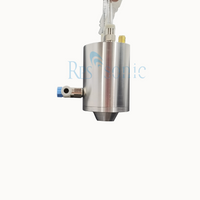Ultrasonic atomization spraying is the use of piezoelectric effect to convert electrical energy into high-frequency mechanical energy, to break up the molecular bonds between liquid water molecules to produce a natural and elegant water mist, so as to atomize the liquid without heating or adding any chemical reagents. .
Ultrasonic high-frequency oscillation is used to atomize the liquid into uniform micron-sized particles. Compared with traditional pressure nozzles, ultrasonic spraying can obtain a more uniform, thinner and more controllable film coating, and it is not easy to block the nozzles. Because the ultrasonic nozzle only needs a tiny air volume of kilopascals, and there is almost no splash during the spraying process, the paint utilization rate is as high as 90%. In the ultrasonic spraying process, the droplet size and distribution can be precisely controlled, so that very small droplet particles can be quickly evaporated, thereby producing particles with a high specific surface area.
Ultrasonic atomization spraying is different from traditional atomization spraying. Traditional spraying relies on pressure and high-speed motion to shear the fluid into small droplets. Ultrasonic spraying uses only ultrasonic vibration energy for atomization. Ultrasonic atomization spray equipment is regarded as a "green" technology due to its low energy consumption and high efficiency, and is an ideal choice for key fluid applications. With its unique gentle spray characteristics, the device greatly reduces back spray, thereby reducing costs and pollution to the surrounding air. At the same time, this new technology also expands more application areas, such as spraying at low flow rates.
Focus mist ultrasonic spray nozzle is an ultrasonic atomizing nozzle with a small spraying width. The ultrasonic nozzle adopted the principle of ultrasonic atomizing technology. It has a special channel design of contracted flow to uniformly distributes the carrier gas, so that the liquid mist after ultrasonic atomization is sprayed in a focused manner, thereby reducing the spraying area of the ultrasonic spray nozzle. Due to the small width of the focus mist ultrasonic spray nozzle, it is mainly suitable for various small and medium-area spray coating applications. The focus mist ultrasonic nozzle is complementary to the wide mist ultrasonic nozzle and can be applied to almost all different plane spray coatings.
The typical applications are fuel cell spray coating, that is, membrane electrode spray coatings in a proton exchange membrane fuel cell. A catalyst (such as a platinum carbon catalyst) dispersion is ultrasonically atomized and sprayed onto a proton exchange membrane to form a uniform and dense membrane electrode. Because focus mist ultrasonic spray nozzle has the advantage of focused spray coatings, it can be precisely sprayed in a small range. Therefore, focus mist ultrasonic atomizing nozzle can also be applied to the surface coating of interventional medical instruments such as drug balloon catheter spray coatings and drug stent spray coatings. For example, focus mist ultrasonic spray nozzles atomize and spray the drug solution which typically consists of rapamycin dissolved in some organic solvents onto the stent or balloon catheter to form a homogenous drug coating.
In addition, focus mist ultrasonic spray nozzle can also be applied to thin film solar cell spray coatings, perovskite solar cell spray coatings, PCB flux spray coatings, etc.
Features
Uniform coating: uniformity >95%
Saving raw materials: raw material utilization rate is over 85%, 4 times that of traditional air spray nozzle
High control accuracy of coating thickness : 20 nm to tens of micron coatings can be precisely sprayed.
Non clogging
Anti-corrosion nozzle
High precision, high controllable spray.
Application
| Electronics | Sensors, PCB Fluxing, Display, Semiconductors etc. |
| Industrial | Glass, Fabrics, plastic,etc. |
| Medical | Medical Textile, Diagnostic Device etc. |
| Energy | Fuel Cell, Solar Cell, etc. |

 English
English

























































